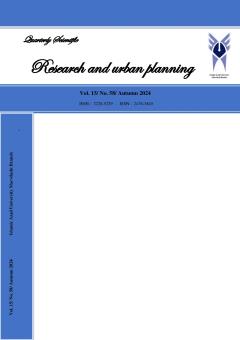تبیین مؤلفههای کالبدی در شکلگیری هویت مکان خیابانهای شهری: مطالعه موردی خیابان شریعتی تبریز
الموضوعات :محسن احد نژاد 1 , مهدی اشلقی 2
1 - استاد گروه جغرافیا، دانشگاه زنجان، زنجان، ایران
2 - دانشآموخته دکتری جغرافیا و برنامهریزی شهری، دانشکده علوم انسانی، دانشگاه زنجان، زنجان، ایران.
الکلمات المفتاحية: شهر تبریز, مؤلفههای کالبدی, هویت مکان, خیابان شریعتی,
ملخص المقالة :
اگر هویت مکان را در قالب «مکان به مثابه مادی»، «مکان به مثابه فضامندی اجتماعی»، و «مکان به مثابه تفاوت تجربی و روانی افراد از فضا» مقولهبندی نماییم، نوشتار پیش رو کوشیده است که در تبیین هویت مکان فضای خیابانی از منظر پوزیتیویستی و پدیدارشناختی بر مولفه نخست آن یعنی فضا به مثابه محیط مادی که خود آفریننده تعامل اجتماعی و شناخت فضایی است را مورد واکاوی قرار دهد. در راستای این هدف، پژوهش حاضر در پی شناخت میزان تاثیرات مستقیم مولفههای کالبدی در متن فضای خیابانی شریعتی تبریز است. این تحقیق از نوع تحقیقات توصیفی- تحلیلی و همبستگی است. در ابتدا به تاثیر فرم فضایی از طریق ویژگی کاربریهای بزرگ مقیاس، تنوع و اختلاط کاربریها، ویژگیهای بافت شهری منطقه(میزان تراکم مسکونی و جمعیتی)، تعداد طبقات ساختمانها، دانهبندی قطعات ساختمانی، امکان نفوذپذیری در بین ساختمانها، دسترسپذیری در امکان دسترسی آسان به فضای عمومی از فضای خیابانی مورد تحلیل قرار گرفت .برای تحلیل این مولفهها در فضای خیابانی ناحیهشریعتی، مدلهای تابع فاصله اقلیدسی، شبکههای عصبی، و آمار فضایی در محیط ArcGIS استفاده گردید. همچنین برای بررسی میزان تأثیر مولفههای کالبدی خیابان بر هویت مکان، دادههای میدانی از طریق پرسشنامه گردآوری و سپس با استفاده از مدل رگرسیون چندمتغیره خطی مورد تجزیه و تحلیل قرار گرفت.
نتایج بررسی نقشهها نشان میدهد که خیابان شریعتی تبریز دارای ویژگیهای کالبدی باکیفیت و قابل قبول است که میبایست مورد توجه عمیق قرار گیرد. نقشهها نشان دادند که ویژگیهای کالبدی و فضایی خیابان شریعتی تبریز میتوانند به عنوان عوامل ایجاد و توسعه هویت مکان مورد توجه قرار بگیرند. نتیجه مدل رگرسیون چندگانه نشان داد که مؤلفههای کالبدی با ضریب تعیین 79 درصد، نقش زیادی در توسعه هویت مکان خیابان شریعتی تبریز ایفا میکند. از این بین، متغیر تنوع فعالیت و کاربری با ضریب بتای 49 درصد، بیشترین تأثیر مثبت را در شکلگیری هویت مکان دارد.
1. Abdul Rahman, N. (2015): What Makes People Use the Street?: Towards a Liveable Urban Environment in Kuala Lumpur City Centre. Procedia- Social and Behavioral Sciences, Vol. 170,No.1, PP. 624-632.
2. Abdullahzadehfard, A. & Rahmani, M. (2016): Designing the Entrance of Today's Cities Using the Identity of Yesterday's Cities of Iran. Quarterly Journal of Geography, Civil Engineering and Urban Management Studies, Vol.18, No.2, PP:25-37.
3. Agnew, J. (1987): Place and Politics: The Geographical Mediation of State and Society. Allen&Unwin, Boston.
4. Arbab, P. & Azizi, M. (2016): Explanation of the Key Criteria of the Process pf Place Identity Formation in the New Urban Development (Case Study: District 22 of Tehran). Honarhaye Ziba, Vol.20, No.4, PP. 5-20.
5. Berghauser Pont, M. & Haupt, P. (2009): Space, Density and Urban Form. PhD. Dissertation of Urbanism. Delft,Technische Universiteit, Delft.
6. Canter, D. (1977): The Psychology of Place. The Architecture Press, London.
7. Castello, L. (2010): Rethinking the Meaning of Place: Conceiving Place in Architecture –Urbanism. Ashgate, Farnham.
8. Cresswell, T. (2019): Maxwell Street: Writing and Thinking Place. Chicago University Press, Chicago.
9. Damayanti, R.. (2015): Extending Kevin Lynch’s Theory of Imageability: Through an Investigation of Kampungs in Surabaya, Indonesia. PhD. Dissertation in Architecture. The University of Sheffield, Sheffield.
10. Daneshpour, A. (2000): Rethinking the Sense of Identity in the Urban Public Spaces(Street): Case Study of Engelaab Street. University of Tehran, Tehran.
11. Dinca, C. (2015): The Death and Life of Great Streets: An Amsterdam Case Study. University of Amsterdam, Amsterdam.
12. Dovey, K. & Pafka, E. (2017): Mapping Urbanities: Morphologies, Flows, Possibilities. Routledge, New York.
13. Evans, R. (2011): Delivering Quality Places, trans S. Daneshpour & A. R. Zoharian. Iran University of Science and Technology, Tehran.
14. Hass-Klau, C. (2015): The Pedestrian and the City. Routledge, New York.
15. Jaberi Moghaddam, M. H. (2005): City and Modernity. Iran Academy of the Arts, Tehran.
16. Jacobs, J. (1961): The Life and Death of Great American Cities. Penguin Books, Harmondsworth.
17. Heydari, A. & Jamshidi, F. (2021): Analysis of the Relationship between the Two Concepts of Place Identty and Place Attachment in Urban Open Spaces (Case Study: Eram Garden of shiraz). Journal Research and Urban Planning, Vol.12, No.44, PP. 173-188
18. Lang, J. & Marshall, N. (2017): Urban Squares as Places, Links and Displays: Successes and Failures. Routledge, New York.
19. Lynch, K. (1960): The Image of the City. The MIT Press, Cambridge.
20. Mousavi, S. & Shakour, A. (2019): Investigation and Role of Urban Signs with Emphasis on Identity of Space (Case study: Shahid Chamran Boulevard, Shiraz). Journal Research and Urban Planning, Vol9, No35, PP. 1-10
21. Pafka, E. (2013): Nothing Gained by only Counting Dwellings per Hectare: A Hundred Years of Confusing Urban Densities. State of Australian Cities Conference, Sydney, PP. 1-9.
22. Sardarinia, S. (2014): Tabriz, the City of the Firsts. Akhtar, Tabriz.
23. Seamon, D. (1991): Toward a Phenomenology of Citiness: Kevin Lynch’s The Image of the City and Beyond. The National Geographical Journal of India, Vol.37, No.1, PP. 178-188.
24. Shokouhi Bidhendi, M. (2010): The Urban Environment is Full of Meaning: Kevin Lynch Revisits Environmental Landscape Planning. Manzar Journal, Vol.7, No.1, PP. 54-57.
25. Talen, E. (2005): New Urbanism and American Planning: The Conflict of Cultures. Routledge, New York.
26. Thiis-Evensen, T. (2012): Archetypes of Urbanism: A Method for the Aesthetic Design of Cities. University of Art, Tehran.
27. Wheeler, J. (1971): Social Interaction and Urban Space. Journal of Geography, Vol.70, No.4, PP. 200-203.


